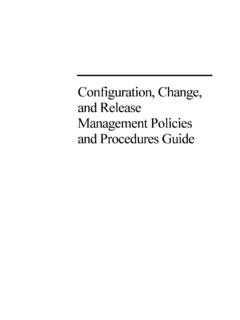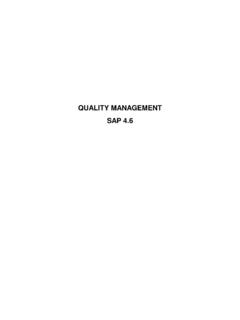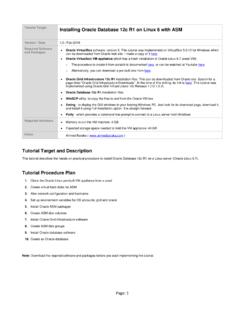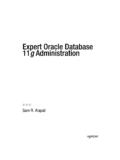Transcription of Oracle Database Capacity Planning
1 1 Oracle Database Capacity PlanningKrishna Capacity PlanningCapacity Planning is essential to deliver a pre-determined optimal/consistent user experience throughout the lifecycle of a Planning refers to identifying the changes (from a Capacity perspective only) needed to be done to the environment to maintain this predefined user experience over the lifecycle of the the simplest of terms, this changes can refer to adding more CPU/Memory/Storage/Network capabilities along with suitable configuration changes to the application (Grid, version upgrades, 64bit vs32bit etc) as and when identified to be Planning or Performance Tuning ?
2 Capacity Planning is pro-active whereas performance tuning is mostly Planning is anticipating demand ahead of time and recommending suitable changes to the Planning (unlike performance tuning) is not an exact science in the sense it requires some guess work based on prior history and experience with the environment. I would feel, Performance tuning is trying to get the best out of existing infrastructure for rewriting sql, creating an index a user complains of poor performance of the application, it is important that you establish if this is a Capacity constraint resulting in sub optimal user experience or code/application Planning can help identify performance issues early Planning ModelCollect StatsMonitor(Update Profile with Stats on a Regular basis)
3 Create ProfileThresholdsDefine Action Plan for threshold violationsEstablish ThresholdsThreshold ViolationsChange based on Action PlanThresholds under controlOne TimePerformance (Application) Capacity ConstraintResolveEstablish Pattern and BehaviourNew RequirementsPredict Possible Threshold Violations5 Collecting stats & ProfilingThe first step is to identify suitable stats and capture them (assuming the application is in steady state). Statistics is from the application as well as the from the infrastructure (CPU/Memory/Storage etc).
4 Then, one needs to start with profiling the the environment will help inUnderstanding the needs of the environmentCorrelating statistics from the application with the and predicting growth using the previously established thresholds and As a result -proper Capacity Planning to meet the an application (contd.)Profile is basically a snapshot of the application. It enables you to see how it is performing with key statistics and changes over a period of can in-turn help identify performance issues and bottlenecks as an additional benefit during the process of capturing profiling is done, the next step is to establish indicate your comfort level for Redo/Day cannot exceed 50GB/day beyond which I need to revisit my redo need to be defined and set for the key statistics in the profile.
5 Also you identify the course of action to be followed if a threshold is the key statistics in the profile on a daily/weekly basis will allow you to plan in advance as to what changes need to be perspectiveHow can I do Capacity Planning on a pro-active basis for my Oracle instance?9 Oracle Capacity planningThe answer to this lies in reviewing, collating and corroborating Oracle statistics with statistics from various other subsystems such as OS, Storage and Network over a period of key is to know which statistics to look at, how to interpret the numbers and establish is essential to know when to drill down into session level stats and when to stick to the top level as otherwise the stats will become to forget.
6 Capacity Planning is pro-active whereas performance tuning is mostly Stats and Wait eventsFrom an Oracle perspective, both stats as well as wait events needs to be captured on an ongoing would capture stats at an instance level and if required at a session begin with, one can start with instance level stats collected every 24 hrs. The finer the interval, the more accurate the results, however it can get very is best not to use the dba_histviews/AWR, but rather collect the stats from the v$ v$viewsare mostly incremental views and contain data from the instance startup time.
7 11 Oracle Stats and Wait events can be collected forWork LoadUser related (Transactions, logons, parses etc)Redo activityUndo activityTemp activityTablespace and object space usagePGA usageSGA usageParallel OperationsIO OperationsFile Stats and Temp Stats12 Oracle Stats and Wait events events help mostly in performance tuning and identifying steady state wait events, Top 10 waits including CPU time ordered by Time Waited along withAverage Wait timeTotal WaitsWait class Filter out idle and parallel (PX*) StatisticsFrom an Infrastructure perspective, to begin with the following stats can be collected.
8 CPU Utilization, run queue, context switches (voluntary and involuntary), interrupts, system calls, thread migrations)Storage Number of IOPS/second, Queue Depth, Size of IOPS, Response time (lunlevel, volume and file), Usage, response time and Physical memory consumed, swap in/out, page faultsNetwork Throughput and details from netstat s and kstat. It is important to note that OS stats are generally not event driven and are time sampled. So they need to be correlated with application stats to make Oracle Instance profileThese stats allow us to create a simple and basic profile of the instance which can be used for daily reporting (shown next slide).
9 It is important to note that even though many magnitudes of statistics are collected everyday, the profile should present only sufficient information to enable a decision to warrant further investigation if Simple profile for a Datawarehouse instance16A Simple profile days ( % Delta)-30 days (% Delta)-7 days (% Delta)TodayThresholdread by other sessionUser file sequential readUser file scattered readUser < 1direct path read tempUser < file syncCommitNot PresentNot file parallel writeSystem I/ONot PresentNot path write tempUser < 1db file parallel writeSystem < file parallel writeSystem I/ONot PresentNot thread startupConcurrency18141818< 12 DWAverage Wait (centiseconds)17 Oracle - Capacity Planning (contd.)
10 To summarizeProfile the environmentCollect and collate initial set of statistics when environment is steady state and user response time is deemed satisfactory Oracle , OS, Storage, Network .Define and establish thresholds Oracle , OS, Storage and Network. As before, user response time should be deemed statistics collection over a defined period of time Maybe monthly or a pattern of change certain statistics increase over a period of time, whereas others on the pattern of change, plan on adding additional any point during this time.








